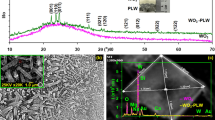Abstract
The laser synthesis method is used to fabricate amorphous dielectric WO3 films on fused silica and c-sapphire substrates at room temperature and thin LiCoO2 films (thickness, 10–60 nm) on c-sapphire and silicon substrates. The films are intended for use as the key components of thin-film all-solid-state electrochromic cells based on flexible polymer substrates. The optical and electrophysical properties and surface morphology of the films prepared at room temperature are studied in relation to the type of subtrate and oxygen pressure used during growth process. Variation of the oxygen pressure has a marginal effect on the surface roughness of the WO3 films, which is 4–5 nm. The type of substrate has almost no influence on the surface roughness of the LiCoO2 films, which on average is 35 nm. Increasing the oxygen pressure inside the vacuum chamber leads to the formation of the WO3 films with better light transmission characteristics in the entire considered range of 200–1000 nm. The transmittance of the LiCoO2 films increases from 30 to 70% in the investigated spectral range of 300–1000 nm. The low-temperature laser synthesis is used in fabricating a WO3-based solid state electrochromic cell. When a voltage of 2 V is applied, its transmittance in the spectral range of 300 to 900 nm decreases by 30% for 2 min.






Similar content being viewed by others
REFERENCES
H. Yang, J. H. Yu, H. J. Seo, et al., Appl. Surf. Sci. 461, 88 (2018). https://doi.org/10.1016/j.apsusc.2018.05.231
D. Qiu, H. Ji, X. Zhang, et al., Inorg. Chem. 58, 2089 (2019). https://doi.org/10.1021/acs.inorgchem.8b03178
G. Yuan, C. Hua, L. Huang, et al., Appl. Surf. Sci. 421, 630 (2017). https://doi.org/10.1016/j.apsusc.2016.10.176
T. Yong, X. Li, J. Bae, et al., Mater. Des. 162, 45 (2019). https://doi.org/10.1016/j.matdes.2018.11.016
O. Nanda, N. Gupta, R. Grover, et al., AIP Adv. 8, 095117 (2018). https://doi.org/10.1063/1.5037454
A. L. Belousov and T. N. Patrusheva, Zh. Sib. Fed. Un-ta. Tekh. Tekhnol. 7, 154 (2014). http://elib.sfu-kras.ru/bitstream/handle/2311/10348/03a_Belousov.pdf; jsessionid=1F76FBFB923DD8104A85B44FC13DCF-75?sequence=1
K. Sauvet, L. Sauques, and A. Rougier, J. Phys. Chem. Solids 71, 696 (2010). https://doi.org/10.1016/j.jpcs.2009.12.069
S.-C. Wang, K.-Y. Liu, and J.-L. Huang, Thin Solid Films 520, 1454 (2011). https://doi.org/10.1016/j.tsf.2011.08.046
J. Li, Q. Jiang, N. Yuan, et al., Materials 11, 2280 (2018). https://doi.org/10.3390/ma11112280
K. Kim, D. Choi, H. Kim, et al., Int. J. Pr. Eng. Man. GT 5, 409 (2018). https://doi.org/10.1007/s40684-018-0043-4
C. S. Ah, J. Song, S. M. Cho, et al., Bull. Korean Chem. Soc. 39, 1186 (2018). https://doi.org/10.1002/bkcs.11574
X. Yan, L. Wang, and X. Qian, Coatings 10, 35 (2020). https://doi.org/10.3390/coatings10010035
D. Wang, L. Wei, P. Shi, et al., J. Alloys Compd. 771, 100 (2019). https://doi.org/10.1016/j.jallcom.2018.08.268
A. Yano, K. Hikima, J. Hata, et al., J. Electrochem. Soc. 165, A3221 (2018). https://doi.org/10.1149/2.0151814jes
K. J. Patel, G. G. Bhatt, J. R. Ray, et al., J. Solid State Electrochem. 21, 337 (2017). https://doi.org/10.1007/s10008-016-3408-z
G. Atak and Ö. D. Coşkun, Opt. Mater. 82, 160 (2018). https://doi.org/10.1016/j.optmat.2018.05.062
A. Mehmood, X. Long, A. A. Haidry, et al., Ceram. Int. 46, 23295 (2020). https://doi.org/10.1016/j.ceramint.2020.06.035
L. S. Parshina, O. A. Novodvorsky, O. D. Khramova, et al., Semiconductors 53, 160 (2019). https://doi.org/10.1134/S1063782619020192
L. S. Parshina, O. D. Khramova, O. A. Novodvorsky, et al., Semiconductors 51, 407 (2017). https://doi.org/10.1134/S1063782617030228
O. A. Novodvorsky, O. D. Khramova, E. O. Filippova, et al., Proc. SPIE 4644, 58 (2001). https://doi.org/10.1117/12.464189
D. Evecan and Z. E. Highly, Curr. Appl. Phys. 19, 198 (2019). https://doi.org/10.1016/J.CAP.2018.12.006
L. S. Parshina, O. A. Novodvorsky, O. D. Khramova, et al., Opt. Quantum Electron. 48, 316 (2016). https://doi.org/10.1007/s11082-016-0586-y
S. Shiraki, T. Shirasawa, T. Suzuki, et al., ACS Appl. Mater. Interfaces 10, 41732 (2018). https://doi.org/10.1021/acsami.8b08926
Funding
The work supported by the Ministry of Science and Higher Education within the State assignment to the Federal Science Research Center “Crystallography and Photonics” Russian Academy of Sciences in part of “synthesis of thin films,” the Russian Foundation for Basic Research (project no. 19-29-03032) in the part of “investigation of thin films.”
Author information
Authors and Affiliations
Corresponding author
Ethics declarations
CONFLICT OF INTEREST
The authors declare that they have no conflicts of interest.
ADDITIONAL INFORMATION
The article is published based on the materials of Interdisciplinary Scientific Platform with International Participation “New Materials and Advanced Technologies”, November 23–26, 2020, Moscow, https://n-materials.ru/.
Additional information
Translated by A. Kukharuk
Rights and permissions
About this article
Cite this article
Parshina, L.S., Novodvorsky, O.A. Low-Temperature Laser Synthesis of LiCoO2 and WO3 Films for Electrochromic Application. Russ. J. Inorg. Chem. 66, 1234–1238 (2021). https://doi.org/10.1134/S0036023621080209
Received:
Revised:
Accepted:
Published:
Issue Date:
DOI: https://doi.org/10.1134/S0036023621080209




